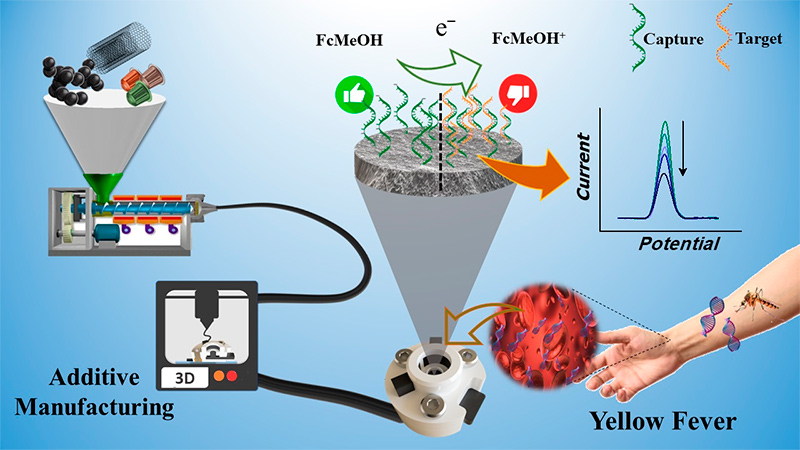personified
The sensor produced from recycled coffee capsules is capable of diagnosing yellow fever
The sustainable device is made using a common 3D printer, can be miniaturized, and detect target sequences of the virus in blood serum samples
Julia Moyoli | FAPESP Agency Because of symptoms similar to other mosquito-borne diseases Aedes aegyptiYellow fever, including chikungunya, dengue and Zika, is not an easily diagnosed arthropod. To overcome this difficulty and speed up appropriate treatment, Brazilian and British researchers have developed an electrochemical biosensor capable of detecting infection, with an added bonus: it is made from recycled coffee capsules, a material that makes it more sustainable and helps reduce its cost. .
The miniature sensor is manufactured using a common 3D printer and meets the criteria for diagnostic testing in remote locations or with few resources defined by the World Health Organization (WHO): accessibility, sensitivity, specificity, ease of use, speed, robustness, and freedom. The equipment can be easily distributed to the end users. Device details were described in the journal Journal of Chemical Engineering .
“Miniature sensors like this can be easily transported to remote areas or communities where yellow fever is more common,” he says. Christian Kalinke, postdoctoral fellow at the Institute of Chemistry at Campinas State University (IQ-Unicamp), visiting scholar at Manchester Metropolitan University (UK) and first author of the article. “This is particularly important in the case of diseases that are common in tropical countries and are considered neglected, and for which prevention and treatment strategies are lacking.”
Operation of the device is simple: its surface contains electrodes 3D-printed in polylactic acid (a biodegradable polymer known as PLA), which comes from processed and recycled coffee capsules. Threads containing carbon nanotubes and carbon black as inserts are responsible for ensuring sensor conduction and generating the electrochemical reaction, in which fragments of yellow fever DNA match the genetic sequence of the patients’ blood serum sample. Only one drop of sample (approximately 200 μL) is sufficient to perform the analysis. Through the difference in signals before and after this contact, the diagnosis is made. In addition, it was also possible to discriminate between findings in samples containing yellow fever and dengue viruses, allowing for an accurate diagnosis of the disease.
One possibility to improve the sensor in the future could be its operation with whole blood samples or even saliva, which would not require processing steps to separate the serum. But to make this happen, new tests will be needed.
according to Giuliano Alves BonacinThe idea is that this model, which uses filaments based on carbon nanotubes and advanced modified materials, can also be replicated to identify other diseases, extending its use to electrochemistry. in the field of health.
work as one team
The interdisciplinary project was developed by Kalinki during his postdoctoral training in England, and involved researchers from the Federal Universities of São Carlos and São Paulo, as well as the Faculty of Science and Engineering at Manchester Metropolitan University (England). The group obtained funding from FAPESP through two projects (19/00473-2 that it 21/07989-4).
“This is a classic example of how when we bring together groups from different universities with complementary expertise, it is possible to do cutting-edge work relatively quickly,” Bonacin says. “If we need to develop all the laboratory parameters to process the polymers already used at BU here, it will take much longer for the work to be completed.”
Article Recycled raw materials for the manufacture of additives using carboxylate multi-walled carbon nanotubes towards detection of yellow fever virus[كدنا]Also signed by Robert D. Crabnell, Evelyn Sigley, Matthew J. Whittingham, Paulo Roberto de Oliveira, Lace C. Brazaca, Bruno C. Janigitz, Craig E. Banks, and can be read at: www.sciencedirect.com/science/article/pii/S1385894723022441.

“Wannabe internet buff. Future teen idol. Hardcore zombie guru. Gamer. Avid creator. Entrepreneur. Bacon ninja.”


